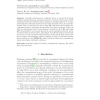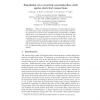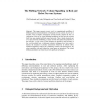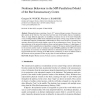167 search results - page 27 / 34 » Modeling self-developing biological neural networks |
NC
2011
13 years 1 months ago
2011
We apply techniques from complexity theory to a model of biological cellular membranes known as membrane systems or P-systems. Like Boolean circuits, membrane systems are defined ...
CONNECTION
2006
13 years 6 months ago
2006
Models of associative memory usually have full connectivity or if diluted, random symmetric connectivity. In contrast, biological neural systems have predominantly local, non-symm...
ESANN
2008
13 years 8 months ago
2008
With the technical development of multi-electrode arrays, the monitoring of many individual neurons has become feasible. However, for practical use of those arrays as bidirectional...
ECAL
2001
Springer
13 years 11 months ago
2001
Springer
This paper presents recent work in computational modelling of diffusing gaseous neuromodulators in biological nervous systems. It goes on to describe work in adaptive autonomous sy...
INFORMATICALT
2008
13 years 6 months ago
2008
Mammalian brains consisting of up to 1011 neurons belong to group of the most complex systems in the Universe. For years they have been one of the hardest objects of simulation. Th...




